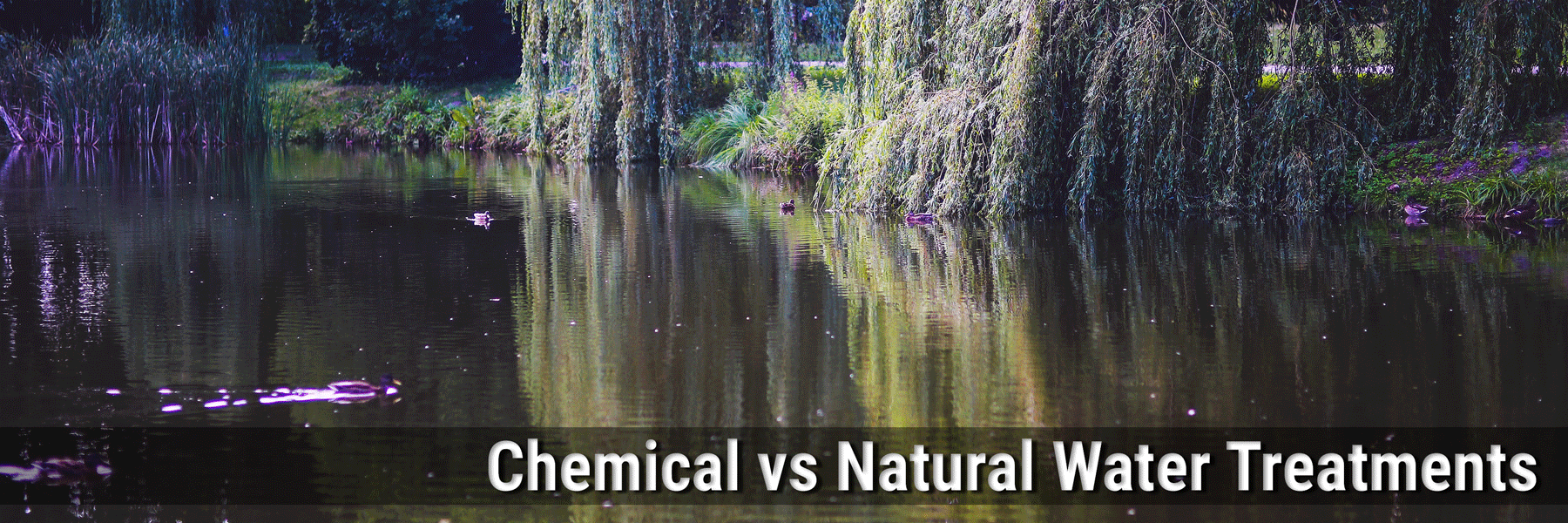Chemical vs. Natural Water Treatments
Chemical treatments (like copper) for lakes and larger earthen bottom ponds are often the first thing reached for to control, or eradicate, algae blooms or excessive and invasive plant growth. Application is initially a success. Water is “cleaned up”; algae and/or seaweed is gone and your body of water looks good again. Over time, each treatment has to be applied sooner and sooner to achieve the same desired results. Costs go up due to frequency of use; and frustration builds…this is just what’s happening outside of the pond.
Inside the pond, each water treatment applied is killing algae/seaweed. Dead plant material drops to the bottom of the pond and begins to decay. Decomposing plant matter uses dissolved oxygen, present in the water, to break down. Due to a limited amount of oxygen, this organic plant matter can only break down partially. Partially decomposed organic matter is muck or sludge – 3 inches of dead algae/seaweed becomes 1.5 inches of muck. With adequate oxygen it decomposes into almost no muck. Look at the mulch in your shrub beds and how it disappears when given time to decompose. There is an old saying, “Every pond is destined to become a meadow.” This is true - without intervention!
Year after year, layer after layer of muck develops.
Water in a pond naturally stratifies into layers by temperature. Warmer water is at the top during the summer while colder water is at the bottom. The opposite occurs during the winter, cold on top, warm water on the bottom. Oxygen enters the water where it meets the air (at the surface). So, the water with the most dissolved oxygen is at the top, not at the bottom where it is needed to help decompose dead plant material.

As seasons change and air temperatures cool, or after a heavy rain; the separated layers in the water begin to mix again as their temperatures draw closer to being the same. This can cause the lake or pond to “turnover” - which means all the dangerous gasses are released at once and devastating fish kills may occur.
Treatment after chemical treatment continues adding waste and debris to the bottom of the pond. Not to mention, all the while, grass clippings, leaves, branches, run-off full of fertilizer, etc. is being added to the water as well. Over time, the pond or lake becomes shallower and shallower (it can take years for this). Chemicals become part of the earthen bottom and water starts to become toxic to any fish, wildlife, or beneficial plant-life around its edges. Before you know it, your once beautiful body of water has become a deadly swamp.
“The best defense is always a good offense.”
The best way to prevent this future heartache and nightmare is to get in front of it. There are many things that can be done to improve the quality of water in your pond or lake. Re-establishing the health and balance in your pond’s ecosystem can be achieved by following these steps. The main ingredients are oxygen, bacteria, enzymes, pond plants and controlling what goes into the water.
Using a true pond aerator to de-stratify the water and move dissolved oxygen to the bottom of your pond or lake will help get rid of waste and decaying plant matter at the bottom. An aerator pumps air through weighted tubing to the bottom of the pond where a diffuser (air stone or diffuser plate) releases small bubbles. As these bubbles rise, they push water up off the bottom. The further these bubbles rise, the less water pressure they encounter and the bubbles expand, pushing more water upwards. The surface area of these bubbles will diffuse oxygen into the water that is touching them. Thus, increasing the amount of dissolved oxygen available in the lake or earthen bottom pond.
Getting dissolved oxygen circulated throughout the water column will accelerate the decomposition of organic waste, get rid of toxic gases in the bottom of the pond, help clarify the water, and creates a much healthier environment for fish and other aquatic life to live and thrive within.
Helpful lake & pond bacteria, added once a year, will start to consume sludge and muck. Adding lake & pond enzymes once to eight times a year will increase the effectiveness of the bacteria by as much as 3 times. There are also muck eraser pellets and packets to concentrate the helpful bacteria in specific areas such as swimming areas and along the shore.

Control what goes into the pond, to begin with, if possible. Do not fertilize your lawn within 10 to 20 feet, depending on the slope of the bank. Blow grass clippings away from the ponds edge and keep the lawn mowed higher around the pond to help keep leaves and debris out.
Aquatic pond plants, such as Marsh Marigolds and Japanese Iris, generally thrive in shallow areas along the water’s edge and remove a tremendous amount of nutrients. Water lilies will not only filter the water and grow beautiful, showy, sometimes fragrant flowers, but also provide cooler shaded areas for fish and frogs to congregate and reproduce.
Stay away from using chemical treatments regularly, which contain heavy metals that can build up and make your pond toxic. Preserve the beauty of your lake or earthen bottom pond by giving it the attention it deserves and maintain a healthy eco-system with natural bacteria, enzymes and proper aeration.
